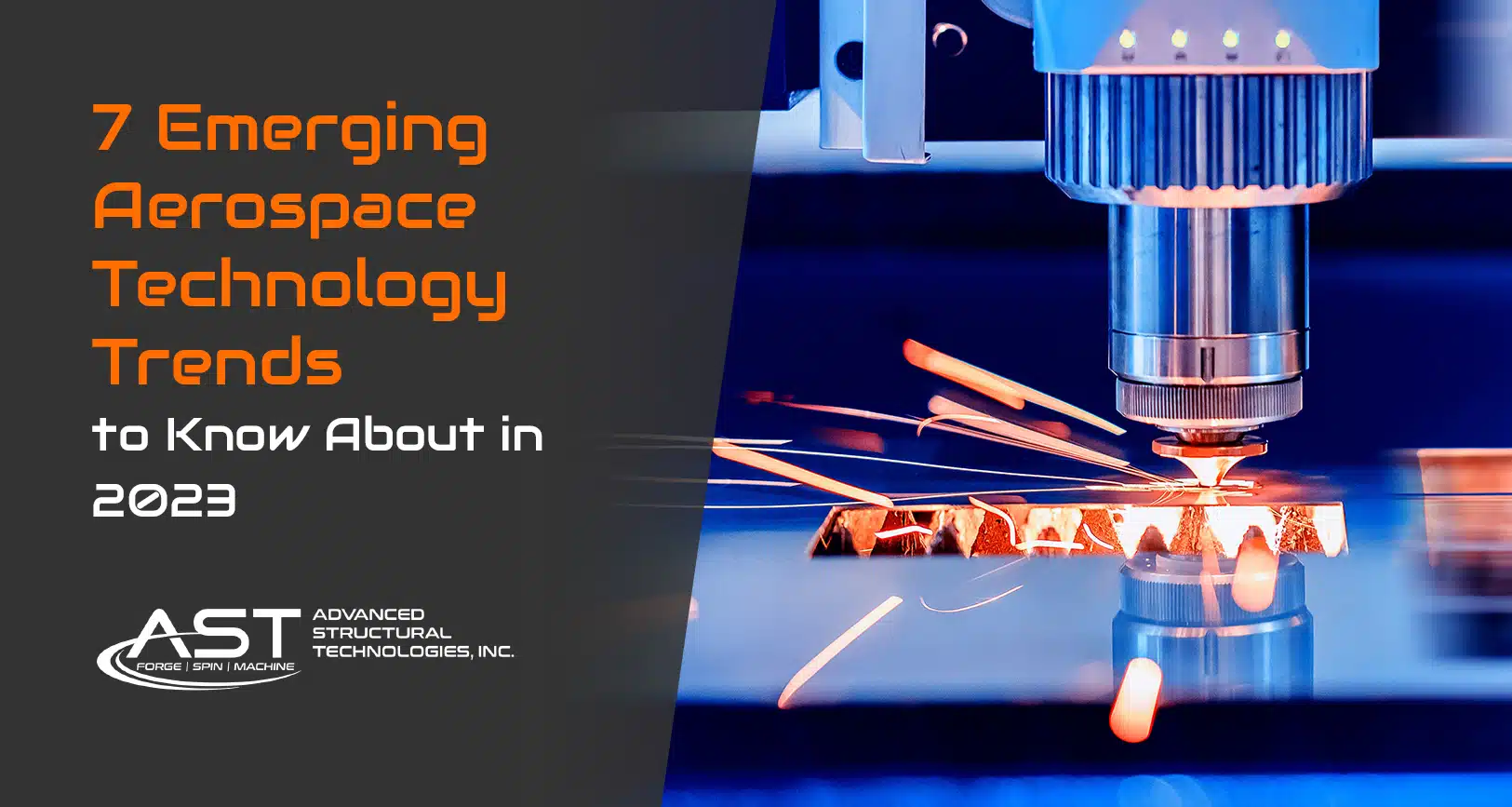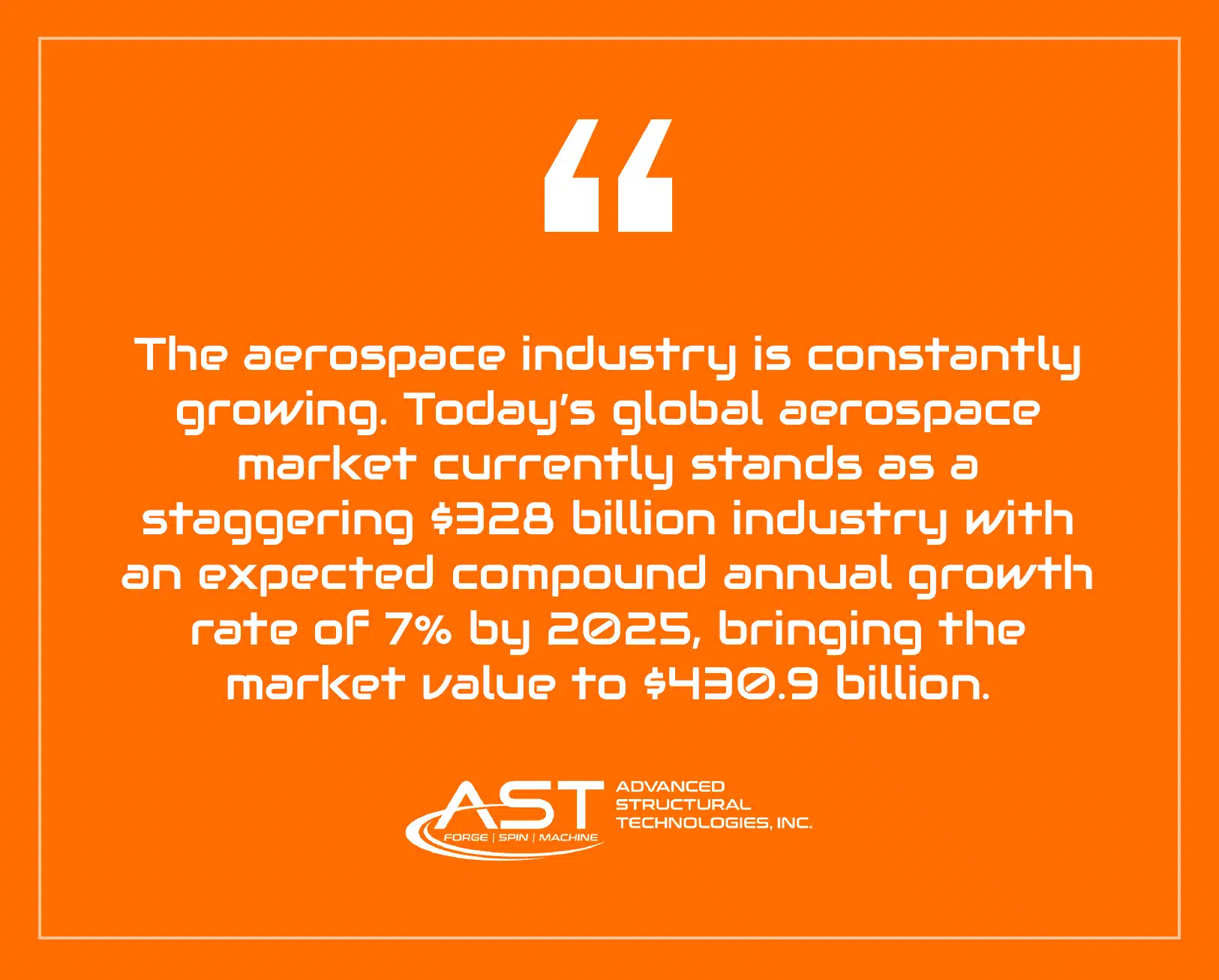7 Emerging Aerospace Technology Trends to Know About in 2023

The aerospace industry is constantly evolving. New technology posed to disrupt the world is continuously in development. Many of these are very early in their development. We may not see their results for decades to come.
However, there are a few that are worthy of our attention today as they’re likely to change the industry within the next decade. Should we ignore these trends, it is likely we will be left behind by our competitors and forced to catch up on the new industry standards.
That’s why today we’re going to take a brief look at how aerospace technology has changed, the major industry major players of today, and discuss the trends of today that will likely affect the industry in the coming years.

What is Aerospace Technology?
When we talk about aerospace technology, we are referring to the methods, systems, and devices used in the practical application of the aerospace industry. More broadly, it refers to the technology that makes spacecraft and aircraft construction possible. This encompasses everything from the invention of the pressurized cabin that allowed aircraft to reach even higher altitudes to developments in jet engine fuel efficiency.
What is Aerospace Manufacturing Technology?
We can consider aerospace manufacturing technology as a niche subsection of aerospace technology. This field specifically refers to the methods and systems that make the fabrication and manufacturing of aerospace components possible. Whereas aerospace technology refers to the development of air- and spacecraft, aerospace manufacturing technology encompasses mechanical assembly and composite fabrication of aerospace materials.
It is the developments in manufacturing that truly make the modern aerospace industry possible.
Is the Aerospace Industry Growing?
The aerospace industry is constantly growing. Today’s global aerospace market currently stands as a staggering $328 billion industry with an expected compound annual growth rate of 7% by 2025, bringing the market value to $430.9 billion.
Despite a brief decline in aerospace demand during the Covid-19 pandemic, this is a marked increase from $276 billion in 2012 with a $52 billion net increase over the last 10 years.
As for the next 10 years, we can expect this trend to continue exponentially, with some researchers projecting revenue to grow upwards to $1,233 billion in the 2030s. Although there is a deviation between market forecasts, they all share the same sentiment that we can expect an explosion of growth in aerospace in the coming decade.
Who Leads the World in Aerospace Technology?
As the aerospace industry grows, so too does the number of companies that participate in it. Some of these companies stand out more than others regarding their contribution to aerospace technology. These companies are at the forefront of aerospace technology.

Here are a few companies leading in the world in aerospace technology.
- Lockheed Martin – In collaboration with Amazon and Cisco, Lockheed Martin recently developed an AI-based telecommunication software called Callisto – a system designed to improve efficiency and situational awareness onboard spacecraft with real-time mission information and connection to ground control.
- Raytheon Technologies – Raytheon Technologies are among the top companies taking on the many aerospace challenges we see today. In September, they announced progress on developing and defending against hypersonic missiles from their Raytheon Missile & Defense company.
- Boeing – Developers of the famous Boeing 747, Boeing develops and manufactures commercial airplanes as well as defense products and space systems. On December 5th, they announced the delivery of the first two 03b mPOWER satellites to SES, a Luxembourgish-French satellite telecommunications network provider. These satellites combine Boeing’s 702 platform, their subsidiary Spectrolab’s custom-designed solar array, and Boeing’s 702X software-defined payload.
- Airbus – Another company known for its airplane designs, Airbus is one of the largest aerospace companies in Europe. In November, Airbus announced its preparations to launch its first megawatt-class hydrogen fuel-cell aircraft test flight in just under four years from now.
- Northrop Grumman – Northrop Grumman markets itself as a pioneering company in the world of aerospace. They develop and build advanced aerospace products such as next-generation spacecraft and aircraft.
And here are the leading space companies.
- SpaceX – SpaceX is famous. This is in part due to the fame of its co-founder, Elon Musk. More importantly, however, they developed the Falcon 9 reusable rocket: the first orbital class rocket capable of reflight. Consequently, many aerospace projects have been able to recover and refly the most expensive rocket components.
- Boeing – In addition to its advances in aircraft, Boeing is constantly pushing the boundaries of space technology.
- Virgin Galactic – A pioneer in space tourism, Virgin Galactic has developed a craft and flight method to achieve a low space apogee of 50,000 feet. Although these flights are expensive to charter, the company is constantly innovating to make the trip more cost-effective.
- Sierra Nevada Corporation – SNC is one of the top companies leading the world in advanced aerospace and national security development, SNC recently began to transition its space systems operations to an independent space company – Sierra Space.
- Airbus Defense and Space – A division of Airbus, Airbus Defense and Space focuses on the development and manufacturing of, as the name implies, defense and space products on behalf of Airbus and is the world’s second-largest space company after Boeing.
All of these companies rely on industrious aerospace manufacturers like Advanced Structural Technologies, Inc that consistently step up to the challenge of space flight by providing high-performance components that were impossible a decade ago. This includes the construction of custom components to aid the space race.
Aerospace Technology Examples
Aerospace Technology has been rapidly evolving ever since the first aircraft left the ground. Since then, numerous innovations have shaped the aerospace industry throughout history.
As we mentioned before, one such example is the Falcon 9 reusable rocket. For much of aerospace history, rockets were a costly one-use component of space travel. As such, the cost – the biggest hindrance to aerospace missions – was drastically reduced for projects deploying this rocket. This cost is expected to be further reduced as this technology is further developed.
Further back in history, we have the solid-propellant rocket. Although these rockets existed throughout history in primitive form, in the mid-20th century, government initiatives and the cold war drove rocketry to a new level. These would eventually become the iconic boosters associated with space flight, offering a cheaper alternative to liquid propellant boosters to help escape the atmosphere.
However, enough with the past. Innovations in aerospace continue today as governments and independent companies continue the mission to advance the industry.
7 Emerging Aerospace Technology Trends
For new aerospace technology in 2023, you only need to look around. Numerous companies are hard at work developing new technology every day as the 21st-century space race continues.
From 3D to printing to artificial intelligence to even blockchain, several new trends in aerospace are taking off today.
1. Autonomous Flight Systems
Autonomous ground vehicles are already a popular and growing trend in the automotive industry, and it is already prevalent for drones. It was only natural that this would eventually reach the aerospace industry. Although this trend has a long way to go before it becomes prevalent, many groups are investing in these autonomous flight systems.
In the short term, we may well see single-pilot commercial aircraft as more and more tasks become automated. However, it will be some time before this technology is scaled enough for us to see fully automated aircraft. Though, we may well see pilotless passenger aircraft in our lifetimes.
2. Additive Manufacturing
Also known as 3D printing, additive manufacturing is growing by the day as a manufacturing solution in aerospace.
This is because this method of manufacturing has allowed companies to produce components with significantly less material than traditional methods. As 3D printing technology progresses, complex geometries are becoming more feasible in this approach. What’s more, the resulting components produced by this method have consistently shown to be durable and lighter.
It is no secret that reliable and lightweight components are becoming increasingly important to the aerospace industry. Lighter components mean improved performance for speed, fuel consumption, and more.
3. Supersonic Flight
The very first aircraft to break the sound barrier did so in 1947. Ever since, companies have invested billions in the development and production of supersonic aircraft.
In August of 2022, American Airlines announced its intent to buy new supersonic airliners from Boom Supersonic. These planes are slated to roll out in 2025 and be put to commercial use by 2029. This will be the first time the sky will see such passenger flights since 2003.
However, for now, these new aircraft are yet to be flight-tested, and the deal is conditional until they meet safety standards. Should this become the new norm for the future of commercial airlines, they will need manufacturers to meet the demand for lightweight and durable materials. AST stands ready with the skills to develop and deliver the necessary components to meet this demand.
4. Artificial Intelligence
AI is a word that’s been on everyone’s lips for a few years now. Almost every industry has found a way to implement this sci-fi-sounding technology from predictive analytics for marketing companies to department stores using machine learning to track merchandise. Aerospace is no different.
AI is capable of superhuman levels of computation, processing massive amounts of data in short periods of time. As such, machine learning offers numerous benefits to the aerospace industry such as the ability to process mass swaths of data for faster material analysis and supply chain management.
By automating these mundane tasks, AI increases the speed at which aerospace researchers are now able to develop all forms of technology. And as technology develops at a faster pace, aerospace companies will need to turn to companies that provide flexible and streamlined manufacturing processes to meet demand.
5. The Internet of Things
A recent trend, specifically for aerospace maintenance and repair, is the implementation of IoT technology. This technology is being utilized to create a predictive maintenance approach to air- and spacecraft by monitoring components. Analyzing this data allows companies to identify breaks and part failures before they happen.
From this data, it is possible to address repairs before part failure. What’s more, this data allows for more and more data gathering to create better components.
This will eventually lead to innovations in aerospace components that will require new manufacturing techniques to address. AST’s in-house engineering is prepared for this circumstance with rapid development and delivery.
6. New Materials
Everyone in the aerospace industry is constantly looking for lighter and stronger materials to use in air and spacecraft. So, it is no surprise that new and advanced materials are being tested and adopted year after year. One such example is the carbon-based material known as graphene, an atom-thick material used in high-capacity, lightweight batteries.
As advanced materials appear, manufacturing adapts to incorporate them.
7. Electric Propulsion
The world is slowly shifting towards electric propulsion. This trend is already well-known in the automotive industry, but it is also true for the aerospace industry. Not only does this shift in propulsion offer a quiet craft with reduced emissions, but it also comes with reduced costs. As such, electric propulsion stands to open new segments of the aerospace industry. That’s why today there are approximately 215 electrically-propelled aircraft currently in development.
Of the trends we’ve discussed today, electric propulsion holds the greatest potential to disrupt the industry as it opens unknown possibilities for the future of space and aircraft design.
Should this method of propulsion become prevalent, we will see manufacturers faced with demands to produce components capable of accommodating it as well as handle the shift in design to aircraft.
Conclusion
From these trends, we can expect serious changes to come to the aerospace industry throughout the next decade. Technology will continue to develop at an exponential rate, bringing with it new challenges to manufacturing to keep pace. That’s why aerospace manufacturers need to remain on top of these trends and be flexible enough to respond to them.
Book a call today with AST to discuss your aerospace manufacturing needs with a company that understands the ever-changing demands of the industry.



